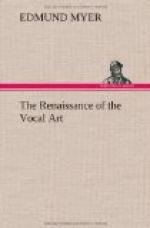At a certain stage of study, when the student of the voice has acquired freedom and control, when he is able to release the face, jaw, tongue, and throat from all local effort or contraction,—at this stage of study it is wonderful what can be done in the way of articulation in a few days, by this system. I have known many singers who could produce beautiful tones, but who could not make themselves understood at all in the singing of a song; yet in a few lessons on these three points or places of articulation, practically applied by the use of words and sentences, they could sing the words of a song as distinctly as it was possible to speak them.
For the practical application of the above principles of articulation, form groups of vowel sounds, and make syllables by adding consonants, and sing them on single or level tones. First place the consonant before the vowel, making the articulation the initial sound of the syllable. Then place the consonant after the vowel, making the articulation the final sound of the syllable. Also sing sentences on single tones or level movements. Analyze all the consonantal elements of the sentence. Take for example the following sentence, “We praise Thee, O God,” and notice at which point or place of articulation each and every consonant is made. Let all articulation be free, flexible, and light in movement, not heavy or labored. Never work with articulation; play with it, but let it be distinct and definite. Make no effort of face, lips, or tongue; let all be free and pliable. Show no effort or contraction of the face in sustaining voice or pronouncing words. In other words, never sing on the outside of the face. Mouth and face must be left free and pliable for the outline of form and for expression. Use words and sentences in an impulsive, impressive manner without local effort.
Articulation must be rhythmically in sympathy with the movement or the rhythm of the song. Even though the voice may flow freely on the vowels, the articulation must not be hurried, nervous or spasmodic. This style of articulation often disturbs the legato flow and spoils the general effect. While of course it is not possible to sing the consonantal sounds, a beautiful effect is often the result of playing upon the consonant rhythmically, with the movement of the song.
ARTICLE THREE.
THE SIXTH PRINCIPLE OF ARTISTIC SINGING.
The sixth principle of artistic singing is
The Elocution of Singing.
Theory.—The words and their meaning, in modern song, are, as a rule, more important than the music.
Devices.—A study to combine elastic vowel form and flexible articulation, applied by the emphasis and accent of important words and phrases; also applied through the color and character of tone, and the impressive, persuasive, fervent voice. In short, a study of pure diction.




